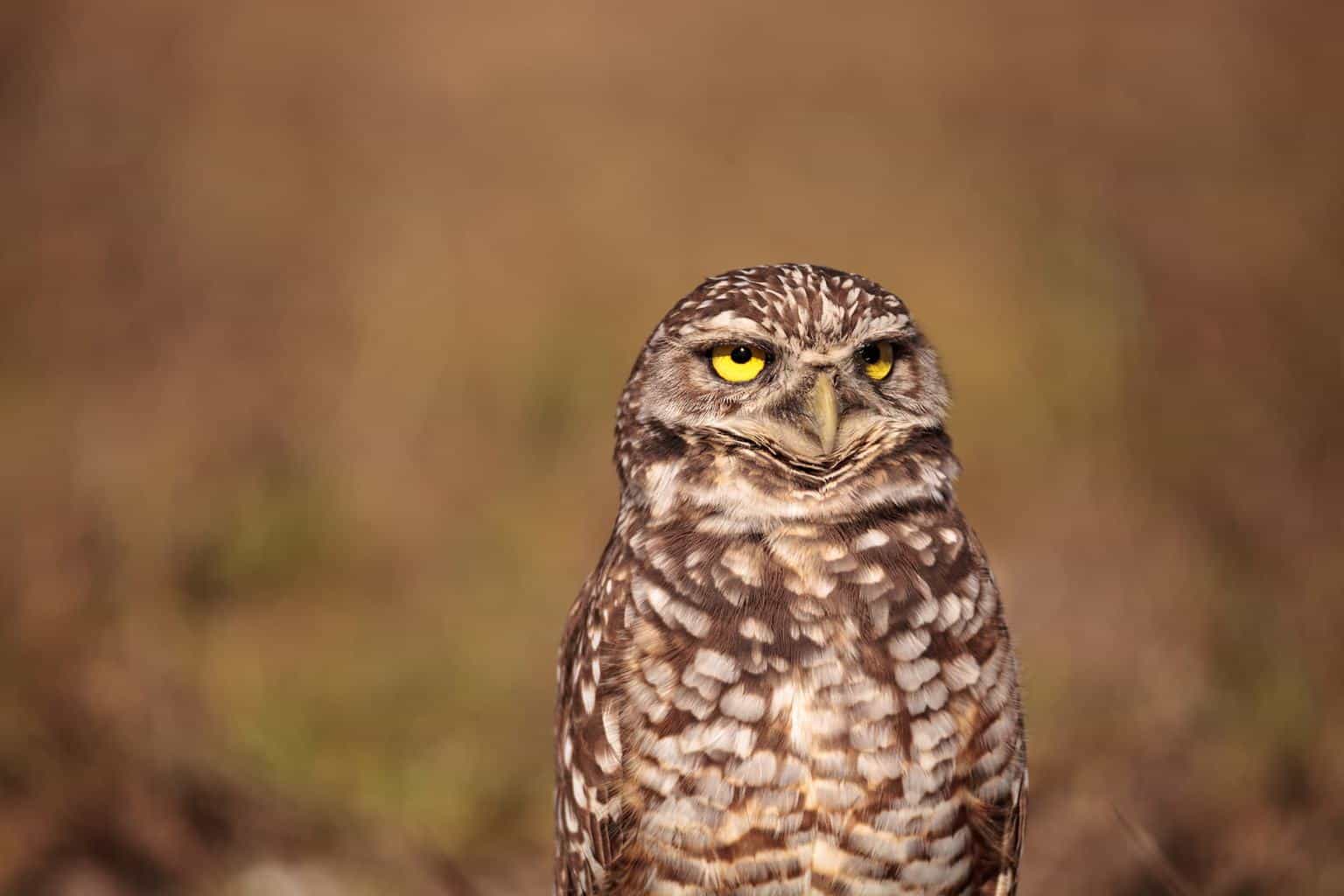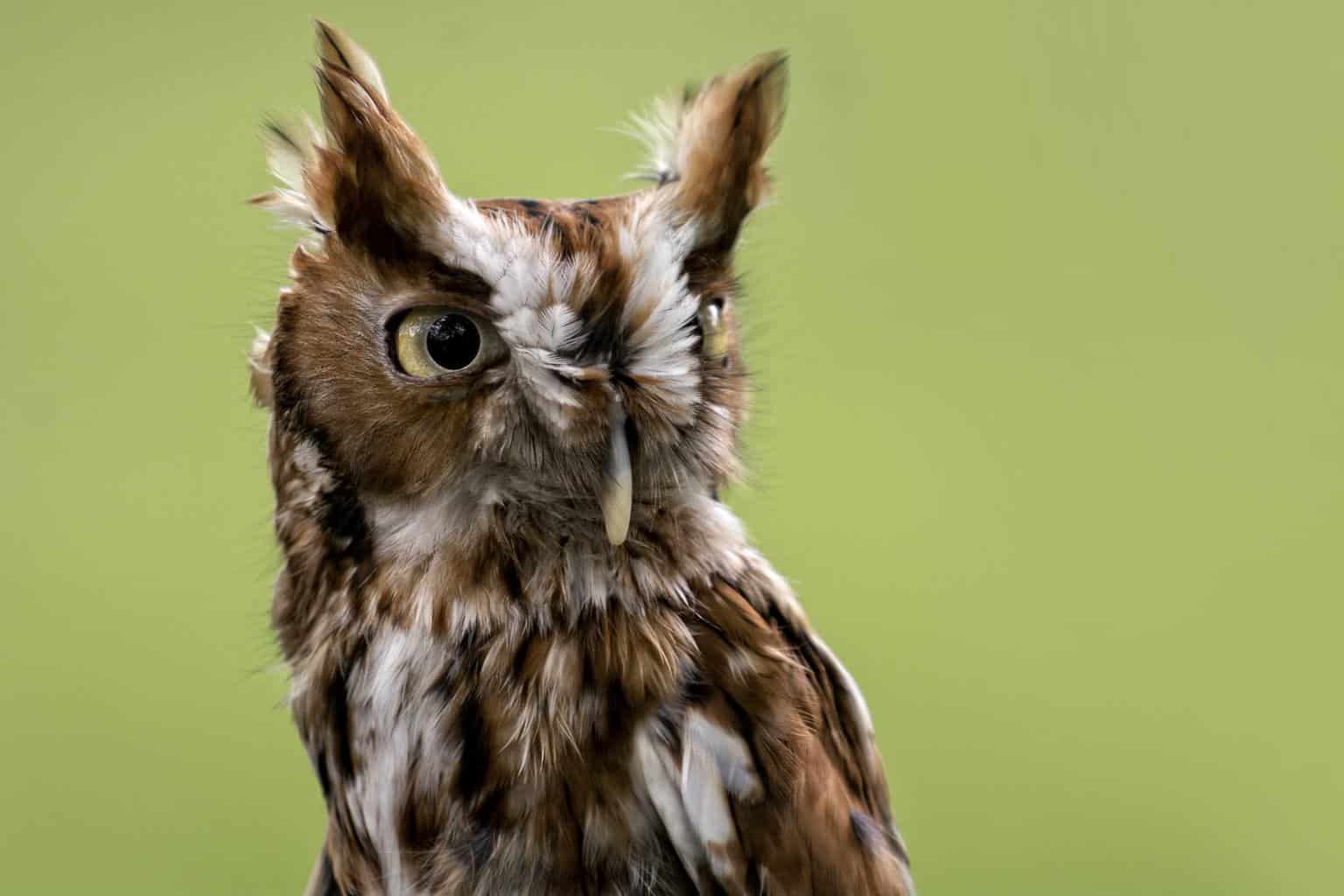Louisiana is home to a wide variety of bird species. In fact, over 470 recorded species of birds reside inside the state’s borders, making it one of the biggest hosts of dazzling birds in the United States!
In this article, we’ll discuss eight beautiful owl species you’ll find in the Pelican State. Read on, bird lover, to learn how to locate and identify these birds the next time you’re in Louisiana!
Barn Owl

- Scientific Name: Tyto alba
- Length: 12.6-15.8 inches
- Weight: 14.1-24.7 ounces
- Wingspan: 39.4-49.2 inches
Louisiana boasts the biggest barn owl population in the United States. These birds coexist with other species of owls in areas where rice fields, sugar cane, and marshlands are plentiful.
Barn owls have incredibly distinct features. They’re mostly pale and ghostly in appearance with eerie, rasping shrieks and almost frightening demeanors.
According to a study conducted in Louisiana’s marshes, the owls’ diet consists primarily of rice rats, cotton rats, and house rats, totaling up to 97.5 percent of their prey. Like most owls, this species hunts at night by flying low over open habitats and using its powerful hearing.
Barn owls got their name from their preferred nesting location: a barn. They’ll also make a nest in abandoned houses, rafters, and under shelters. Living inside allows them to protect themselves from outdoor predators as their brightly-colored plumage can easily be spotted from above.
Barred Owl

- Scientific Name: Strix varia
- Length: 16-25 inches
- Weight: 26 ounces
- Wingspan: 38-49 inches
According to the Louisiana Ornithological Society, barred owls are among the most common Louisiana owls in the Strigidae family. They’re widely recognized for their brown and white striped plumage and distinct call that sounds as if the bird is asking “Who cooks for you? Who cooks for you all?”
Barred owls are among the most beautiful species of owls in the Pelican State, and they’re often described as cute because of their large and round brown eyes and fluffy faces.
Unlike most owls, barred owls aren’t fully nocturnal, which means they can be seen during the day.
Barred owls are slightly smaller than their great horned owl cousins and are far less aggressive. When territorial disputes happen, barred owls would simply leave and find a new home rather than defend their territory.
These owls are commonly found in the cavities of large, deciduous trees and evergreens, often near bodies of water. They don’t migrate or change living locations unless threatened.
Burrowing Owl

- Scientific Name: Athene cunicularia
- Length: 7.5-9.8 inches
- Weight: 5.3 ounces
- Wingspan: 21.6 inches
Burrowing owls are among the smallest species of owls in Louisiana. They have rounded heads, long legs, short tails, and an almost regal posture and facial expression.
Despite their short build, burrowing owls won’t hesitate to attack when threatened. They’re often spotted in open habitats with little to no vegetation, like deserts, prairies, pastures, shrubsteppe, and even airports.
As the species’ name suggests, burrowing owls live in abandoned burrows that formerly belonged to prairie dogs, tortoises, and ground squirrels. They use these burrows as both hiding grounds and mating nests. Because of this, burrowing owls have a higher carbon dioxide tolerance than other birds.
Burrowing owls’ diet primarily consists of insects found on the ground, small mammals, amphibians, and other birds. They’re not picky eaters, and they’ll usually settle for anything depending on the season and food availability.
Unlike most owls, where females are larger than males, female and male burrowing owls are the same size.
Eastern Screech-Owl

- Scientific Name: Megascops asio
- Length: 6-10 inches
- Weight: 5.6 ounces
- Wingspan: 19-24 inches
Eastern screech-owls are another fairly common species in Louisiana. They’re usually identified by their signature screech-like trilling call that becomes active at dusk.
Similar to burrowing owls, screech-owls are small and stocky with rounded wings, square tails, and pointed ear tufts that are usually raised and contribute to their distinctive silhouette.
Most screech-owls are speckled grey or reddish-brown and can therefore blend excellently against the bark of a tree. The physical characteristic protects and camouflages them from larger birds of prey like great horned owls, great grey owls, and snowy owls.
Screech-owls can be seen nesting in evergreen or deciduous trees near water, and their diet consists of large insects, including beetles, moths, and crickets, as well as mice and bats.
Great Horned Owl

- Scientific Name: Bubo virginianus
- Length: 18.1-26 inches
- Weight: 50 ounces
- Wingspan: 55.2 inches
When you think of owls, great horned owls probably come to mind first. They’re the largest species of these birds found in Louisiana and the third-largest owl in North America!
Great horned owls, sometimes called tiger owls, are among the Americas’ most common and widely distributed owls. They’re named after their long, horn-like ear tufts and greatly intimidating soldier-like look.
These owls are big, broad, and barrel-shaped with reddish-brown faces and mottled grey-brown feathers. Their calls consist of a series of four to five stuttering hoots, which are primarily heard deep into the night.
Great horned owls live in all kinds of habitats, ranging from deciduous and evergreen forests to deserts and tundra edges. They can also be seen in cities, parks, suburbs, and orchards.
Due to their large size, great horned owls can easily take on large prey, including peregrine falcons and ospreys, as well as burrowing and eastern screech-owls. They’re so strong that their talons require up to 28 pounds of force to pry open!
These birds are fearless and aggressive, and they wouldn’t hesitate to attack prey larger than themselves. Thankfully, they only attack humans when they feel threatened.
Long-Eared Owl

- Scientific Name: Asio otus
- Length: 13.7-15.7 inches
- Weight: 8.8 ounces
- Wingspan: 35.5-40 inches
Long-eared owls, also known as northern long-eared owls, lesser horned owls, and cat owls, are medium-sized birds that sport a distinguishing surprised expression on their faces. They have long tufts of feathers that point straight up and almost resemble exclamation points and wide yellow eyes.
These owls typically spend their days roosting in the dense parts of trees, their plumage excellently camouflaging them from any potential threat. They’re among the most vocal species of owls, possessing a wide variety of vocal sounds, including hoots, barks, squeals, and screeches.
Long-eared owls are usually found in grasslands, tall and dense shrubs, and open country spaces. Pine stands and shelterbelts are among their favorite locations to roost during the winter months.
This species of owls hunts mostly at night, looking for common local rodents, including deer mice, voles, kangaroo rats, and the like. They also eat small birds, snakes, and lizards.
Northern Saw-Whet Owl

- Scientific Name: Aegolius acadicus
- Length: 6.5-9 inches
- Weight: 1.9-5.3 ounces
- Wingspan: 16.5-22.2 inches
Northern saw-whet owls are the smallest species found in Louisiana, sure to make you say, “aww!” when you see them. They have adorable oversized heads with cat-like faces and bright yellow eyes, all framed with a heart-shaped facial disk.
These birds are named after the sound of a whetstone sharpening a saw. They have a distinct “too-too-too” call that’s head during the evenings, but only from January through May in mountainous evergreen forests.
Similar to most other owls, northern saw-whet owls feed on small rodents like mice, voles, and young squirrels. They also wouldn’t say no to the occasional large insect and a small bird.
Northern saw-whet owls aren’t as common in Louisiana as the other owls on this list. If you’re lucky, you can find them in deep coniferous forests, oak woodlands, or streamside groves.
Short-Eared Owl

- Scientific Name: Asio flammeus
- Length: 13-17 inches
- Weight: 7.3-16.8 ounces
- Wingspan: 33.5-40.5 inches
Short-eared owls have an extensive range, and they can be seen in all regions of the state.
The species is mostly found during the wintertime in the western half of the Pelican State, but once the weather turns warmer, these owls head back to northern Canada and across Alaska to breed.
Short-eared owls vary from buffy to white underneath and barred on their upper breasts and throats. This makes them look two-toned below and faded in flight. These owls are relatively quiet, but once they call, it’s strongly reminiscent of the sharp barking of a small dog. Some say they sound like a cat looking for a mate.
The best places to spot short-eared owls are open grass fields, marshes, and meadows. Some short-eared owls have also been reported at airports.
Unlike most owls, this species is diurnal. This means they’re often seen hunting in the daylight, early in the morning until dusk. Their favorite meal consists of squirrels, mice, small songbirds, rodents, and voles.
Final Thoughts
Louisiana is known for housing an impressive number of birds and animal species. After all, it contains a generous selection of perennial streams, deciduous or mixed forest, and other bottomland swamps and forests, making it the ideal habitat for all kinds of wildlife.
When it comes to owls, Louisiana protects and studies eight stunning species. Each of the owls listed above has its own unique characteristics and habitats, so if you’re an avid birdwatcher planning to catch a glimpse of one of these beautiful owls, it’s best to study their behaviors and how they interact with humans.
Need to know more about Louisiana’s birdlife? Check out our list of Louisiana woodpeckers!

